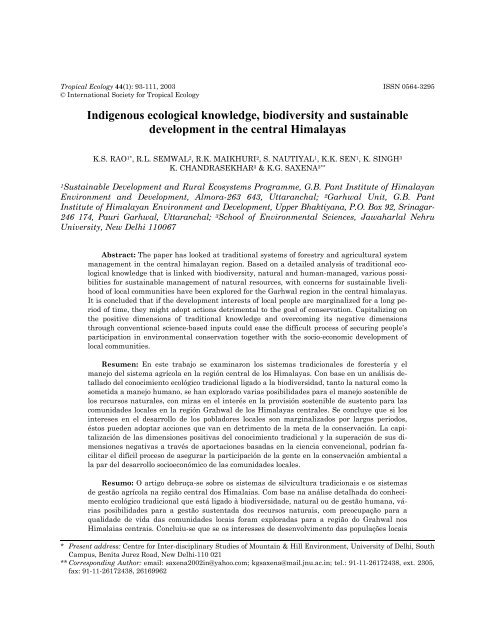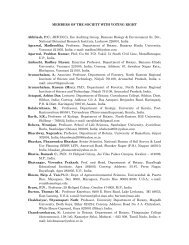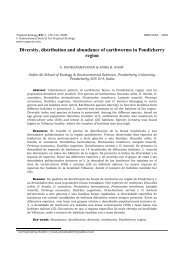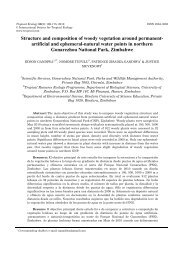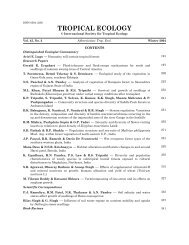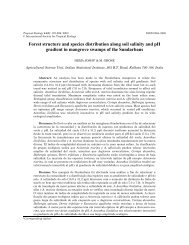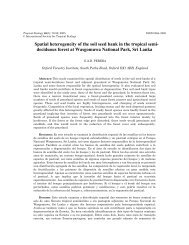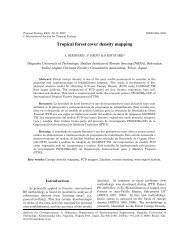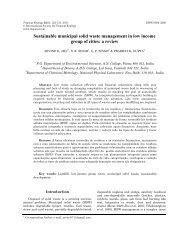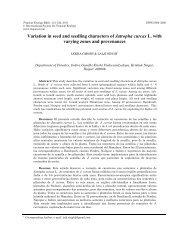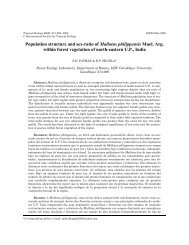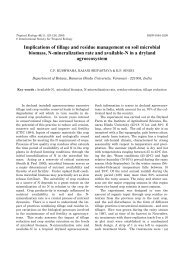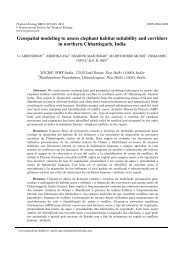Indigenous ecological knowledge, biodiversity and sustainable ...
Indigenous ecological knowledge, biodiversity and sustainable ...
Indigenous ecological knowledge, biodiversity and sustainable ...
Create successful ePaper yourself
Turn your PDF publications into a flip-book with our unique Google optimized e-Paper software.
RAO et al. 93Tropical Ecology 44(1): 93-111, 2003 ISSN 0564-3295© International Society for Tropical Ecology<strong>Indigenous</strong> <strong>ecological</strong> <strong>knowledge</strong>, <strong>biodiversity</strong> <strong>and</strong> <strong>sustainable</strong>development in the central HimalayasK.S. RAO 1* , R.L. SEMWAL 2 , R.K. MAIKHURI 2 , S. NAUTIYAL 1 , K.K. SEN 1 , K. SINGH 3K. CHANDRASEKHAR 3 & K.G. SAXENA 3**1Sustainable Development <strong>and</strong> Rural Ecosystems Programme, G.B. Pant Institute of HimalayanEnvironment <strong>and</strong> Development, Almora-263 643, Uttaranchal; 2 Garhwal Unit, G.B. PantInstitute of Himalayan Environment <strong>and</strong> Development, Upper Bhaktiyana, P.O. Box 92, Srinagar-246 174, Pauri Garhwal, Uttaranchal; 3 School of Environmental Sciences, Jawaharlal NehruUniversity, New Delhi 110067Abstract: The paper has looked at traditional systems of forestry <strong>and</strong> agricultural systemmanagement in the central himalayan region. Based on a detailed analysis of traditional <strong>ecological</strong><strong>knowledge</strong> that is linked with <strong>biodiversity</strong>, natural <strong>and</strong> human-managed, various possibilitiesfor <strong>sustainable</strong> management of natural resources, with concerns for <strong>sustainable</strong> livelihoodof local communities have been explored for the Garhwal region in the central himalayas.It is concluded that if the development interests of local people are marginalized for a long periodof time, they might adopt actions detrimental to the goal of conservation. Capitalizing onthe positive dimensions of traditional <strong>knowledge</strong> <strong>and</strong> overcoming its negative dimensionsthrough conventional science-based inputs could ease the difficult process of securing people’sparticipation in environmental conservation together with the socio-economic development oflocal communities.Resumen: En este trabajo se examinaron los sistemas tradicionales de forestería y elmanejo del sistema agrícola en la región central de los Himalayas. Con base en un análisis detalladodel conocimiento ecológico tradicional ligado a la biodiversidad, tanto la natural como lasometida a manejo humano, se han explorado varias posibilidades para el manejo sostenible delos recursos naturales, con miras en el interés en la provisión sostenible de sustento para lascomunidades locales en la región Grahwal de los Himalayas centrales. Se concluye que si losintereses en el desarrollo de los pobladores locales son marginalizados por largos periodos,éstos pueden adoptar acciones que van en detrimento de la meta de la conservación. La capitalizaciónde las dimensiones positivas del conocimiento tradicional y la superación de sus dimensionesnegativas a través de aportaciones basadas en la ciencia convencional, podrían facilitarel difícil proceso de asegurar la participación de la gente en la conservación ambiental ala par del desarrollo socioeconómico de las comunidades locales.Resumo: O artigo debruça-se sobre os sistemas de silvicultura tradicionais e os sistemasde gestão agrícola na região central dos Himalaias. Com base na análise detalhada do conhecimentoecológico tradicional que está ligado à biodiversidade, natural ou de gestão humana, váriasposibilidades para a gestão sustentada dos recursos naturais, com preocupação para aqualidade de vida das comunidades locais foram exploradas para a região do Grahwal nosHimalaias centrais. Concluiu-se que se os interesses de desenvolvimento das populações locais* Present address: Centre for Inter-disciplinary Studies of Mountain & Hill Environment, University of Delhi, SouthCampus, Benita Jurez Road, New Delhi-110 021** Corresponding Author: email: saxena2002in@yahoo.com; kgsaxena@mail.jnu.ac.in; tel.: 91-11-26172438, ext. 2305,fax: 91-11-26172438, 26169962
94 BIODIVERSITY AND SUSTAINABLE DEVELOPMENTforem marginalizados por um longo período, elas podem adoptar acções que são detrimentaispara os objectivos da conservação. Capitalizar nas dimensões positivas do cohecimento tradicionale ultrapasar a sua dimensão negativa através de inputs de base científica podem facilitaro processo difícil de garantir a participação da população na conservação ambiental juntamentecom o desenvolvimento sócio-económico das comunidades locais.Key words:Biodiversity, natural resource management, rehabilitation ecology, <strong>sustainable</strong> livelihood,traditional <strong>knowledge</strong> <strong>and</strong> technology.IntroductionThe Himalayan mountain system covers only18% of the geographical area of India, but accountsfor more than 50% of India’s forest cover <strong>and</strong> for40% of the species endemic to the Indian subcontinent.Himalayan resources <strong>and</strong> ecosystem servicesare critical, not only for the <strong>sustainable</strong> livelihoodof 115 million mountain people, but also for amuch larger population inhabiting the adjoiningIndo-Gangetic plains. Depletion of forest cover,<strong>biodiversity</strong> <strong>and</strong> terrestrial carbon stock, decliningfarm productivity, increasing hydrological imbalance<strong>and</strong> soil erosion are interconnected problems<strong>and</strong> the root-causes of the poor economy of the hillpeople <strong>and</strong> threaten global environmental benefitsfrom the Himalayas (Chipika & Kowero 2000;Hamilton 1987; Hurni 1999; Ives & Messerli 1989;Myers 1990; Ramakrishnan et al. 1996).Until the 1970s, environmental conservation<strong>and</strong> rural development were, by <strong>and</strong> large, treatedas independent sectors. The poor results broughtby the sectoral approach catalyzed efforts towardsthe integrated approach, which targets the resolutionof environmental <strong>and</strong> socio-economic problemssimultaneously. Though <strong>knowledge</strong> of the principles<strong>and</strong> potential advantages of this approach hasimproved considerably in recent years, there aregaps in <strong>knowledge</strong> <strong>and</strong> serious problems in puttingthe theory to practice (Antunes & Santos 1999;Bellamy & Johnson 2000; Jenssen & Goldsworthy1996; Lunde & Iremonger 2000).A simplistic view of integrated managementwould be to identify ‘key’ interventions [analogousto the concept of keystone species (Paine 1969;Walker 1991)] enabling environmental <strong>and</strong> socioeconomicbenefits simultaneously. There are twodivergent approaches to the characterization of theproblem-complex (multiple interlinked problems)or key interventions to overcome the problemcomplex:(a) building on the ways in which nature,resources <strong>and</strong> livelihood have been viewed by theindigenous/traditional communities, which hasbeen referred to as the ‘internal perspective’ approach(Hurni 2000) or as the indigenous <strong>knowledge</strong>-basedapproach or the bottom-up approach;<strong>and</strong> (b) the conventional scientific approach, orglobal economic <strong>and</strong> environmental world-view,referred to as the ‘external perspective’ approach(Hurni 2000), or top-down approach. <strong>Indigenous</strong><strong>knowledge</strong> is an integral dimension of all societiesbut is more intact in areas, such as high-altituderemote Himalayan villages, where inaccessibility<strong>and</strong> isolation have acted as barriers to outsideforces for a long period of time. In this article, wediscuss some aspects of indigenous <strong>knowledge</strong>basedresource uses of management practices <strong>and</strong>changes therein, <strong>and</strong> of the scope for integratingindigenous <strong>knowledge</strong> <strong>and</strong> conventional <strong>ecological</strong>science for resolving <strong>biodiversity</strong>/environmentalconservation-development conflicts, within thecontext of the Himalayan mountain systems.Forest/wild <strong>biodiversity</strong>: impacts ofinterventionsCrop husb<strong>and</strong>ry, animal husb<strong>and</strong>ry, wild <strong>biodiversity</strong><strong>and</strong> rural economy are subsystems of theintegrated traditional resource management system.On a regional scale, the l<strong>and</strong>scape can be differentiatedinto: i) settled crop-livestock mixed agriculturepatches dispersed in the matrix of forests<strong>and</strong> pastures; ii) almost pristine areas (permanentsnow area <strong>and</strong> adjoining alpine vegetation) practicallyimpossible to access for any consumptive resourceuse; iii) the remaining areas that are used
RAO et al. 95for summer grazing by transhumance communities,the Gaddis <strong>and</strong> Bakarwals, who bring livestockfrom the distant foothill regions <strong>and</strong> the Anwals,Tarjias <strong>and</strong> Dogpas who supervise the livestockof the local hill communities. Traditionalsocio-cultural mechanisms of fostering systematic<strong>and</strong> regulated use of wild plant resources seem tohave evolved as a necessity to optimize economicoutputs from domesticated <strong>biodiversity</strong>. All acrossthe region, traditional management systems arecharacterized by practices favouring a balance inutilization <strong>and</strong> regeneration of the natural resourcebase, equity <strong>and</strong> social integrity to achievethe ultimate goal of <strong>sustainable</strong> livelihood withinsmall-scale subsistence economies in highly isolated<strong>and</strong> inaccessible mountain settlements. Conventionalapproaches to conservation, i.e., the establishmentof wildlife sanctuaries <strong>and</strong> nationalparks, have assumed traditional practices to bedetrimental to the conservation of wild <strong>biodiversity</strong><strong>and</strong> the functioning of ecosystems. This assumptionis the root-cause of people-conservation conflicts(Gadgil et al. 1993; Gomez-Pompa & Kaus1992; McNeely 1988). The nature <strong>and</strong> magnitudeof these restrictions, their impacts on local livelihood<strong>and</strong> people’s responses to them may vary dependingupon the <strong>ecological</strong> <strong>and</strong> socio-economic<strong>and</strong> cultural contexts.Traditional forest/wild <strong>biodiversity</strong>managementTraditionally, each village had notional territoriesof forests <strong>and</strong> alpine meadows <strong>and</strong> resourceuses within these ‘common l<strong>and</strong>s’ were decided bythe consensus of the communities. Even thoughlocal people were aware of potential economicbenefits from timber, the timber trade was neverpractised because they traditionally viewed theutilization of non-timber forest products <strong>and</strong> ecosystemservices to be more valuable for <strong>sustainable</strong>livelihood than timber. In the traditional system,there was no restriction on the collection ofwild edibles, deadwood <strong>and</strong> leaf litter (to be usedas a constituent of manure applied to crop fields),partly because these resources were abundant.Lopping, grazing <strong>and</strong> utilization of forest productssuch as medicinal plants <strong>and</strong> bamboos (raw materialfor h<strong>and</strong>icrafts) used to be undertaken ingroups during periods fixed by the consensus of thecommunity so as to reduce the risks of overexploitationby individuals. Traditions such as thesocial sanction to market forest resource-basedh<strong>and</strong>icrafts, medicinal plants <strong>and</strong> nomadic grazingonly by smallholders <strong>and</strong> l<strong>and</strong>less people fosteredequity to a significant extent. Villages rich in someresources due to comparative <strong>ecological</strong> advantages(e.g. villages close to the alpine zone arericher in summer fodder, temperate bamboos <strong>and</strong>medicinal plants than those in mid-altitude zones<strong>and</strong> those in foothills which are richer in winterfodder) allowed other villages to use their resources,more from the point of achieving socialintegrity than from the point of economic gains(Maikhuri et al. 2000a,b; Rao & Saxena 1996). Localcommunities traditionally allowed grazing oflivestock from outside the region supervised bynomads for three reasons. First, nomads used thearea not grazed by local livestock <strong>and</strong> hence didnot offer any threat to local livelihood. Second, thepresence of livestock brought by nomads to the areasaround the villages reduced the probability ofdepredation of local livestock. Third, the nomadsbartered essential commodities, which were notavailable locally <strong>and</strong> brought from the foothillswith local products.Leopards <strong>and</strong> wolves are the two major predatorsof livestock studied in the region. In highaltituderegions, local people view wolves as amore serious threat than snow leopards becausethe former is a year-round predator on domesticlivestock, whereas the latter attacks mostly duringextreme winters. Estimates on livestock killing bysnow leopards fall within a range of 1% to 12% oftotal stockholding (Fox et al. 1988; Jackson 1991;Mallon 1991; Mishra 1997; Oli et al. 1994; Schalleret al. 1987). The assessment of killings by wolveshas not received as much attention as those bysnow leopards. Precise estimation of predationlosses is difficult because predation as a proximatecause of livestock death is confounded with ultimatecauses such as disease, malnutrition, badweather or accidents. All assessments of livestockdepredation are based on killings reported byfarmers who often deliberately inflate the figures.Livestock are less able to escape predatorsthan wild herbivores (Nowell & Jackson 1996).Local people traditionally accepted depredation asa natural hazard. Several measures are taken tominimize this loss. First, grazing of goats, sheep,donkeys <strong>and</strong> cows is kept close to permanent settlements.Two families, by rotation in a village,
96 BIODIVERSITY AND SUSTAINABLE DEVELOPMENTassemble all livestock of the village, accompanythem for grazing in areas away from crop fields inthe morning <strong>and</strong> bring them back to the respectivehouseholds in the evening. All animals are kept inrooms, the integral part of a dwelling. Second, robustmales are selected <strong>and</strong> kept as communityanimals so as to enhance the escape capabilities ofdomesticated animals. Then only yaks, dzomo/dzo<strong>and</strong> horses are taken to distant summer grazinggrounds (temporary summer settlements). Heretoo, animals that are more valuable are kept inencampments fenced by a 3-4 m high stonewallduring nights. Graziers make fires at night as ameasure to keep predators away. They haveevolved abilities to sense the presence of predatorsin the vicinity through the abnormal behaviour oflivestock. At the approach of predators, they shout<strong>and</strong> throw stones to keep them away. A few lessvigorous animals are kept outside encampmentsduring the night to reduce the attacks on morevaluable animals within encampments.Retaliatory killings of snow leopards by localpeople are likely only when an animal causes frequent<strong>and</strong> large-scale damage <strong>and</strong> when leopardsare found guarding kills of large domestic animals(Fox & Ch<strong>and</strong>awat 1988; Fox & Nurbu 1990; Oli etal. 1994). On the other h<strong>and</strong>, wolves are killedwhenever possible. Many villages have stone-pitwolf traps. Traditionally, the community (Fox &Nurbu 1990; Mishra 1997) rewards individualswho succeed in capturing pups.Blue sheep <strong>and</strong> snow cocks are traditionaldelicacies, but local people rarely go out with theintention of hunting these herbivores, partly becauseof religious-social-cultural norms discouragingwildlife killings (Fox & Nurbu 1990; Mallon1991) <strong>and</strong> partly because of the great ability ofthese herbivores to escape. Whenever a blue sheepis captured, all families of the village share itsmeat. People also underst<strong>and</strong> that a reduction inthe population of wild herbivores might increasethe frequency of attacks on livestock. Thus, thereseems no immediate threat to the snow leopard’sor wolf’s main natural prey from traditional practices.Policy driven changesThe utilization of forest resources for nationaleconomic/industrial development <strong>and</strong> environmentalconservation was introduced as policy goalsdistinct from those related to people-forest relationships.Ground actions to achieve these policygoals were coupled with actions that led to drasticchanges in traditional uses of forests <strong>and</strong> wildplant diversity. The majority of village commonl<strong>and</strong>s were taken over by the government <strong>and</strong> notifiedas forest <strong>and</strong> wastel<strong>and</strong> in late nineteenthcentury with the implementation of the first forestpolicy. As at present, government forest l<strong>and</strong> wasstratified into: i) national parks where all consumptiveresource uses are strictly prohibited; ii)wildlife sanctuaries where traditional wildlifehunting is an offence but local communities maybe allowed some traditional plant resource usesfree of any cost; iii) reserve forest where concessionsto local communities are more liberal incomparison with those provided in the sanctuaries;resources can be exploited to meet the nationaleconomic/industrial raw material dem<strong>and</strong>s by governmentagencies; iv) community forests whosemanagement is entrusted to local institutions suchas the Forest Council (locally called Van Panchyatin the Uttranchal Himalayas) or to the traditionalvillage headman (locally called Gaon Budha/Siemin some parts of the north-eastern Himalayas);village institutions are authorized to decide onlyon subsistence needs <strong>and</strong> government approval toundertake any extraction on a commercial scale<strong>and</strong> have to share benefits from any commercialextraction with the government. There were twoimportant generic implications of changes in forestl<strong>and</strong> tenure/ownership <strong>and</strong> resource-use practicesimposed by policy <strong>and</strong> law: the reduction in areafreely accessible to local people <strong>and</strong> emergence of alocal perception that policies promote conservationor national economic development on a resourcebase that local people have conserved.GrazingInfluenced by the policies promoting forest resource-basedeconomic development, local peoplehave also begun to give more attention to monetarybenefits than to the traditional linkage betweenresource uses <strong>and</strong> social integrity <strong>and</strong> equity.In the N<strong>and</strong>a Devi Biosphere Reserve, alltraditional alpine meadows of a number of villages(e.g., Lata <strong>and</strong> Peng) became a part of sanctuary/nationalpark. The unaffected villages (e.g.,Malari) permitted livestock of the affected villagesto graze in their territories but on payment of Rs.20/horse or head of cattle <strong>and</strong> Rs. 4/sheep or goat.Such linkages between resource rich <strong>and</strong> poor vil-
RAO et al. 97lages did not depend on any monetary considerationin the traditional system.Indeed, the termination or reduction of grazingrights in forests <strong>and</strong> meadows may enhance plantdiversity <strong>and</strong> ecosystem functioning if the grazingpressure is intense. Long-term benefits to localcommunities from such enhancement may encouragethem to reduce livestock holdings <strong>and</strong> switchover to alternative livelihood strategies (Fox 1993;Maikhuri et al. 2000b; Sharma & Shaw 1993).Such responses are likely only when the unsustainabilityof traditional grazing practice is demonstrated<strong>and</strong> people are compensated for economiclosses due to termination/reduction of grazingrights within protected areas. There is no scientificevidence to show that traditional grazingpractices always cause loss of <strong>biodiversity</strong> <strong>and</strong> ecosystemfunctioning (Gabriel et al. 1998; Ward et al.1998, 2000). If the disturbances caused by traditionalresource uses were moderate, diversity maydecline following ab<strong>and</strong>onment of these uses <strong>and</strong>the recuperation of lost diversity may be a veryslow <strong>and</strong> costly process (Kotiluoto 1998; Stampfli& Zeiter 1999). Ecological impacts of traditionalresource uses <strong>and</strong> management need to be scientificallyevaluated before they are ab<strong>and</strong>oned ormodified using legal instruments.Medicinal plantsTraditionally, medicinal plant collection was asubsidiary activity when people went away fromtheir dwellings to graze livestock. This resourcewas used for local health care as well as to generatesome income. The government granted permitsto individuals/contractors during 1980s <strong>and</strong>started earning some revenue through this practice.Contractors, by <strong>and</strong> large, employed outsidelabour rather than local people, as the latter werelikely to place greater stress on the extractionregenerationbalance than on maximization ofprofits. Local people strongly opposed this policy,partly because they did not get any direct benefits<strong>and</strong> partly because of the threat to their livelihooddue to un<strong>sustainable</strong> harvesting by the outsidelabour. In the face of strong opposition from thepeople, this practice was terminated in 1988.Wood resourcesThe government sanctioned felling to contractorsduring 1970s as a way of earning revenuefrom timber, as well as serving national industrialdevelopment. Foreseeing the adverse environmentalimpacts of commercial felling on steepslopes <strong>and</strong> the long-term consequences of such impactsas concerns the lowering of the productivityof non-timber forest products, hydrological imbalance<strong>and</strong> soil erosion, local people agitated <strong>and</strong>forced the government to withdraw fellings. Thisagitation (popularly referred to as the Chipkomovement, i.e., ‘hugging the tree’ movement),which was confined to the Uttaranchal Himalayaswas so effective that the government bannedfellings not only in the Uttranchal hills, but also inall mountain regions of the country. The removalof dead/diseased trees in Reserve Forests startedin the 1960s <strong>and</strong> continues. Government agenciescan sell dead/diseased trees in Reserve Forests,but forest councils can do so only with governmentapproval. If the market value of the proposed removalis assessed at Rs 5000 or less, the council isallowed to auction the deadwood <strong>and</strong> if more thanRs 5000, the auction is carried out by the forestdepartment. In the latter case, 10% of income goesto the forest department as institutional charges,36% for management of community forests jointlywith the council, 18% to the district developmentboard for district-level development projects <strong>and</strong>36% to the revenue department for development inthe concerned village. Lack of complete autonomyin mobilizing income from community forest resourcesis an issue in the people-government conflict.Rural development as a component ofprotected-area managementIn the traditional system, protection from exploitationby outsiders or insiders was a collectiveresponsibility; each household had to contributesome m<strong>and</strong>ays towards protection. Policy interventionsviewed protection as enforcement rather thana social responsibility. Protection accounts for asubstantial proportion of government expenditureon conservation, but as far as the people are concerned,it is an unproductive investment, as it doesnot directly benefit them.Provisions of direct economic benefits to localpeople are being increasingly incorporated in protected-areamanagement plans. Afforestation, mechanicalsoil conservation measures <strong>and</strong> supply ofsolar power devices, wool, improved bee-hives <strong>and</strong>spinning devices at subsidized prices to selected
98 BIODIVERSITY AND SUSTAINABLE DEVELOPMENThouseholds, have been included in the biospherereserve management plan. Yet, local people largelyperceive the benefits far less than the losses due toenforcement. This perception seems to stem from adivergence in the development options preferredby the local people from those incorporated inmanagement plans (Table 1), a perception whichin turn is rooted in the negligible involvement ofthe people in reserve management planning <strong>and</strong>monitoring. Indeed, people’s perceptions may notalways be true when evaluated scientifically. People’spreferred ways of resource uses may not necessarilyfall in line with the goal of conservation<strong>and</strong> hence might need moderation (Maikhuri et al.1995; 1996; 1997a,b,c; Rao et al. 1999; Ward et al.2000), as exemplified in subsequent sections inthis article.People-wildlife conflictsPenalties for killing wildlife imposed by protected-areamanagers are another key change thatfollows the enforcement of protected areas. Localpeople dislike this policy as it treats outsiders whohunt wildlife for game or economic gains the sameas it does local people who resort to killing onlywhen a wild animal turns extremely hostile. Sucha policy is also viewed by local people as a way ofpromoting conservation at the cost of their livelihood.The involvement of local people in the surveillanceof game or commercial hunting, togetherwith interventions that keep the predators awayfrom settlements <strong>and</strong> their resource catchments,could be a way of resolving this conflict.Though it has been argued that the frequency oflivestock killings has increased in the recent pastbecause of an increase in the livestock population(Mishra 1997), the possibility of an increase in thepredator population following strict conservationmeasures implemented since 1972 cannot be completelyruled out. Protected-area management doeshave a provison of cash compensation for livestockkilled by wildlife, which is indeed an advantage tolocal people conferred by the conventional conservationapproaches. However, the available funds aretoo low to compensate for the losses <strong>and</strong> the proceduretoo complex to be understood by the community(Maikhuri et al. 2000b; Mishra 1997; Rao et al.2002). The policy of compensation also contributedto an erosion of the traditional institutions concernedwith depredation. The enhancement of traditionalpractices to protect livestock from wildlifedepredation is likely to be a more effective way ofresolving wildlife-people conflicts in developingcountries than providing cash compensation.Table 1. People’s perceptions of development options in the N<strong>and</strong>a Devi Biosphere Reserve, centralHimalayas (after Maikhuri et al. 2000b).Development optionsIncrease in crop yields:by exp<strong>and</strong>ing farm holdingsby using chemical fertilizersImprovement in livestock productivity:by increasing fodder productivity of degraded forest l<strong>and</strong>sby replacing traditional breeds with high yielding breeds% of total responsesVillages nearto core zone214948Villages awayto core zoneIncome from timber of dead trees in community forests 96 92Improvement in margins of profits from local products:by local cooperative societiesby value addition locallyby protective government policiesOpening of core zone for tourism 98 96Plantation of coniferous trees by Reserve Authority 24 12Replacement of traditional beehives by ones provided by Reserve Authority 4 8Replacement of traditional looms, beehives, by new devices <strong>and</strong> supply of solarpower panels provided by Reserve Authority6 4181898212828121298
RAO et al. 99Traditional agriculture <strong>and</strong> emergingchangesTraditional settled farming systems in the centralHimalayas are characterised by: i) cultivationof three crops in two years in low-altitude villages<strong>and</strong> one crop per year in high-altitude villages; ii)community decision on the period of fallowing (thevillage is divided into two halves termed Mulla<strong>and</strong> Malla Sar, each household owns at least oneplot in each Sar, <strong>and</strong> a Sar is fallowed during onewinter-crop season over a period of two years) butindependent household decisions on choice of crop<strong>and</strong> management practices; iii) exclusive use oforganic manure derived from livestock excretamixed with forest leaf litter; iv) exchange of seedswithout any monetary considerations; v) use oflocal cultivars. Traditional agriculture has undergoneprominent changes in the recent past inmany segments of the Himalayas. Though there isno perceptible change in cropping intensity, thearea under agriculture <strong>and</strong> crop diversity <strong>and</strong> husb<strong>and</strong>rypractices have changed. Echinochloa frumentacea,Glycine max, Setaria italica <strong>and</strong> Pennisetumtyphoides at lower altitudes <strong>and</strong> Hordeumvulgare at higher altitudes, have been ab<strong>and</strong>oned,while the area under cash crops Solanum tuberosum(potato) <strong>and</strong> Phaseolus species has substantiallyincreased (Appendix I). These changes haveaccompanied substantial improvements in the localeconomy, but at significant environmental cost.The expansion of potato, the by-products of whichdo not have any fodder value, implies a lower productionof fodder from private farms <strong>and</strong> therebygreater pressure on forest use. Further, soil erosionfrom potato fields could be 6-8 times higherthan that from traditional staple food crops (Table2), despite of an organic manure input which is 2-4times higher in the former as compared to the latter.Larger quantities of manure input imply moreremoval of litter from forests <strong>and</strong> hence risks ofdeterioration in forest ecosystem services (Maikhuriet al. 2000b; Sen et al. 1997). A change suchas the cultivation of medicinal plants (which usedto be harvested from the wild <strong>and</strong> many of whichare recognized as rare <strong>and</strong> endangered species), anindigenous <strong>knowledge</strong>-based response, falls in linewith the goal of conservation. On the other h<strong>and</strong>,changes like the loss of traditional lesser-knowncrops <strong>and</strong> cultivars <strong>and</strong> the negative environmentalimplications of potato cultivation do notserve the goal of conservation.Traditional water management <strong>and</strong>changes thereinTraditionally, the upl<strong>and</strong> people have capitalizedon sub-surface water sources <strong>and</strong> small rainfedrivulets (Table 3). Sub-surface flows were thepreferred sources of potable water. This preferenceto sub-surface water necessitated conservation offorests around sources. While drinking watersources were used <strong>and</strong> managed separately bylower <strong>and</strong> higher caste groups, there used to be aunified canal irrigation system for the entire village(Saxena et al. 1994). Though a huge quantityof water is available from snow-fed rivers, peoplerarely used it for two reasons: (a) the water flow istoo fast to be managed with the traditional capacity<strong>and</strong> (b) river water contains a much higher contentof coarse particles <strong>and</strong> is cooler, propertiesconsidered undesirable for drinking or irrigationpurposes. The traditional concerns of water managementthus centered around minimum energy ormaterial inputs for purification, storage <strong>and</strong> canalizationof water, minimal interference with naturalTable 2. Soil loss from different crop fields <strong>and</strong> terrace slope in the Pranmati watershed of the centralHimalayas (after Sen et al. 1997).Soil loss from terrace slope (t ha -1 yr -1 )CropLow (
100 BIODIVERSITY AND SUSTAINABLE DEVELOPMENTTable 3. Traditional water management systems in the central Himalayas.Name of traditionalsystemGoolsChoyasDharaTechnical featuresWater from rainfed small rivers called Gaad orrivulets called Gadhera is diverted to agriculturalfields through a network of channels enablingflow along gravity. Points of stable perennialflow are identified on the natural course. Ifthe flow is slow or sources dry up for some timein the lean season, a small storage tank is constructed.The tank is desilted almost every year.Tiny seasonal seepages, very close to farm fieldsdischarging water insufficient for canalizationare called Choyas. The flow is diverted towards aterrace. Whenever water accumulates, the excess,if any, flows to the terrace below. Farmfield connected.Dharas are believed to be undergorund waterchannels that get exposed usually on lower ormid-slopes. Water recharge <strong>and</strong> flow are adequateenough to yield a perennial clear <strong>and</strong>perpetual water thread. A small shallow tank isusually dug <strong>and</strong> lined with locally availablestones/slates below the point of exposure. Waterdirectly from the exposed source is used fordrinking <strong>and</strong> cooking <strong>and</strong> from the tank forother household purposes. This tank is oftenconnected to another unlined tank below usedfor retting fiber plants like Grewia, Cannabis<strong>and</strong> Urtica.Management featuresA hamlet or village was the operational managementunit for water management. Distributionof irrigation water <strong>and</strong> responsibilities ofmaintenance of tank/ channels among householdswere decided by a selected group of eldersconstituting the ‘Pani Panchayat (Water Council)’.Usually, a group of 3-4 households is identifiedfor repairing canals in the face breeches orobstruction to water flow due to accumulation ofstones in the stretches lying outside privatefarml<strong>and</strong>s. These households are rotated on anannual basis <strong>and</strong> are compensated by food grainsor money by the remaining households.This system is an environmental opportunity fora few households <strong>and</strong> not for the entire village. Itis managed independently by the concernedhousehold(s).By <strong>and</strong> large, drinking water sources of lowercaste people were in more difficult terrain <strong>and</strong>away from dwellings, compared to those ofhigher caste people. Sources are managed collectivelyby the concerned caste groups.hydrological processes <strong>and</strong> minimal risk of damageto life <strong>and</strong> cultivated l<strong>and</strong> from overl<strong>and</strong>flow.The traditional systems became ineffective inmost cases when irrigation <strong>and</strong> drinking watersupply were provided as government service facilities.People did benefit, in that water wasprovided as a free commodity, but the benefitcould not be sustained for long. An analysis of acluster of villages showed that the area underirrigated farming declined in more than 50% ofthe villages between 1971-81 (Rao & Saxena1994). This failure has largely been because ofthe inappropriateness of the water harvesting<strong>and</strong> distribution technologies, which were introduced,<strong>and</strong> of the management institutions(Kothyari et al. 1991).Traditional <strong>knowledge</strong>-basedecosystem rehabilitation strategiesOut of the 59-million ha total geographicalarea of the Indian Himalayas, 7.3 million ha aredegraded community l<strong>and</strong>s <strong>and</strong> 13.5 million hadegraded government forest l<strong>and</strong>s. In many villages,per capita cultivated l<strong>and</strong> is lower than percapita degraded forestl<strong>and</strong>. Though numerous l<strong>and</strong>rehabilitation projects have been implementedsince the 1970s, the impact has, by <strong>and</strong> large, beenpoor because of inappropriate technologies <strong>and</strong>because of the callous or negative attitudes of thelocal people. In mountain regions, active participationby local people is a prerequisite to the successof any rehabilitation effort. One way of securingpeople’s participation would be to formulate a re-
RAO et al. 101Table 4. People’s preferences for rehabilitation ofdegraded l<strong>and</strong>s. Total number of respondents 70.People’s preferences were sought before initiationof the project (after Rao et al. 1999).L<strong>and</strong> use optionTreatments/inputs% of the respondentssupporting l<strong>and</strong> useoptionPlantation of trees 8Plantation of bamboo (Thamnocalamus58spathiflorus)Cultivation of medicinal plantsAconitum heterophyllum 34Allium stracheyi 34Angelica glauca 34Carum carvi 34Nardostachys gr<strong>and</strong>iflora 17Orachis latifolia 9Picrorhiza kurrooa 34Podophyllum hex<strong>and</strong>rum 17Rheum australe 34Saussurea lappa 9Swertia chirayta 9Tanacetum tomentosum 34Thalictrum foliosum 17Introduction of both bamboo <strong>and</strong>27medicinal speciesProtection from grazing 100Soil management/organic manuring100Decision makingBy formal village institutionsNilBy entire village community informally100People’s contributionVoluntary labourNilFarm yard manure 95Propagules/seedlings/saplings98from community forestReinvestment of a portion of returns95for replication of the reha-bilitation modelhabilitation strategy which addresses the people’sneeds/priorities <strong>and</strong> to complement/supplementindigenous <strong>knowledge</strong> /informal institutions withconventional scientific <strong>knowledge</strong>/formal institutions.A comparative <strong>and</strong> concise account of successfull<strong>and</strong> rehabilitation achieved in a highaltitudevillage <strong>and</strong> a low-altitude village (Tables 4& 5) is presented in the following sections.People’s perceptionsAt both locations, people were more concernedabout immediate tangible benefits from rehabilitationthan about indirect/intangible benefits (soilconservation, hydrological balance, carbon sequestration<strong>and</strong> <strong>biodiversity</strong> conservation, the primenational <strong>and</strong> global concern; they were aware of allthese aspects, except for carbon sequestration).Over 90% of the respondents did not prefer exclusivetree plantation, which has been a commonintervention for rehabilitation by governmentTable 5. People’s preferences for rehabilitation ofdegraded community l<strong>and</strong>s (after Maikhuri et al.1997a,b).Treatments/inputsAfforestationConiferous speciesLocal multipurpose broad-leaved species% of totalresponse*AgroforestryLocal multipurpose trees + cash crops 87Local multipurpose trees + staple food crops 5AgriculturenilWater management 64Proper terracing 58Organic manuring 98Inorganic fertilizers 8Decision makingBy formal institutions 7By entire village community informally 87By other means 6People’s contributionVoluntary labournilOrganic manurenilSocial fencing 98Seedlings/saplings from private farml<strong>and</strong> 98Seeds of cash crops 98Reinvestment of a portion of returns for 92replication of the rehabilitation model*Total number of respondents: 21926
102 BIODIVERSITY AND SUSTAINABLE DEVELOPMENTagencies. The reasons for this dislike of exclusivetree plantation were:(a) Coniferous timber species, viz., Pinusroxburghii, P. wallichiana, Cupressus torulosa<strong>and</strong> Cedrus deodara were planted on a large scalein degraded forestl<strong>and</strong>s. The choice of coniferousspecies was based on their well-known silviculture,their non-palatability, which is advantageousin natural protection from grazing <strong>and</strong>their ability to establish themselves in poor soilconditions. Coniferous species are not highly valuedin respect of leaf litter, fuel wood <strong>and</strong> minortimber required in bulk quantities to sustain traditionallivelihood. There is evidence to show thatconiferous forests may not render as favourable ahydrological balance <strong>and</strong> slope stability as broadleavedforests (Singh et al. 1992), but local peopledid not perceive this of the service dimension ecosystem.(b) Income is a major local concern, but thepolicy does not provide for timber extraction formonetary benefits, in view of the risks of soil erosion<strong>and</strong> hydrological imbalance by tree cutting<strong>and</strong> associated disturbances in the fragile Himalayanl<strong>and</strong>scape.(c) Local people were involved merely as labourersbecause their wages were much lower thanthose of the outside labour force. It was assumedthat the traditional <strong>knowledge</strong> <strong>and</strong> experiences ofthe local people would not confer any technical orpractical advantage.(d) It was assumed that selected speciescould withst<strong>and</strong> all sorts of soil stresses <strong>and</strong> hencethere was a lack of any basal improvement in soilphysico-chemical properties in plantation programmes.(e) Seedlings/saplings were raised in centralizednurseries <strong>and</strong> damage during the course oftransport led to the transplanting of unhealthyindividuals (Rao & Saxena 1994; Saxena et al.1993).At high altitude, the planting of temperatebamboo (Thamnocalamus spathiflorus, locally referredto as Ringal) was the most common choice,followed by the cultivation of medicinal plants,while at low altitude, people stressed multipurposetree-cash crop integrated agroforestry (Table 6).The choice of these species was based on their economicpotential, comparative <strong>ecological</strong> advantages<strong>and</strong> some indigenous <strong>knowledge</strong> of their husb<strong>and</strong>ry.Decision-making by the entire village communityrather than a few elected individuals suggestedthat people had lost faith in formal institutions<strong>and</strong> intended to rejuvenate traditional consensusdecisions. Even though they were assuredthat all benefits from the proposed rehabilitatedsite would go to the community, none of the respondentsagreed to voluntary labour. They suggestedthat their contribution would be in terms ofsocial fencing (the community would ensure thatthe treated area was protected from grazingthrough their traditional regulatory mechanisms),supply of seeds <strong>and</strong> seedlings/saplings from thecommunity forests <strong>and</strong> farmyard manure.Moderation of people’s perceptionsAn analysis of people’s perceptions revealedstrengths <strong>and</strong> weaknesses of the indigenous<strong>knowledge</strong> <strong>and</strong> provided scope for overcoming theweaknesses. The challenge was how people’s perceptions<strong>and</strong> priorities could be integrated withnational/global priorities. In the high-altitude village,the following points were gathered from theexisting scientific <strong>knowledge</strong> <strong>and</strong> from a rapid <strong>ecological</strong>survey of the regional l<strong>and</strong>scape. These aspectswere either altogether unknown or, their implicationswere not properly understood by thepeople:(a) The people were not aware of the biologicalpeculiarity of Thamnocalamus spathiflorus,viz., its gregarious flowering <strong>and</strong> low productivityfor 3-4 years after flowering. As bamboo floweringis unpredictable, pure plantation of this specieswould be risky.(b) T. spathiflorus <strong>and</strong> many medicinal specieswere regenerating in shaded <strong>and</strong> moist microhabitatsin Q. leucotrichophora-Aesculus indica-Juglans regia mixed forests. Local people valuedthese tree species for their multipurpose products.Bamboo <strong>and</strong> medicinal species requested for plantationwere thus likely to survive the continuedgrowth of tree canopy. Apart from a range of products,planting of trees in degraded l<strong>and</strong>s couldbring in micro-environmental changes facilitatingnatural regeneration of medicinal plants <strong>and</strong> temperatebamboo. A shortfall in grass fodder productionwas expected with the development of treecanopy because most palatable grasses grew inopen habitats. This shortfall was likely to be compensatedby income from bamboo, medicinal plants<strong>and</strong> tree products.
RAO et al. 103(c) The cultivation of medicinal species wasa risky proposition because of the poor agronomic<strong>and</strong> <strong>ecological</strong> <strong>knowledge</strong> pertaining to them.(d) Medicinal species, being tender herbs,would require intense weeding <strong>and</strong> soil managementfor success in degraded sites. Since privatefarm fields had better soil fertility <strong>and</strong> were partlyab<strong>and</strong>oned, cultivation of these species would bemore advantageous in ab<strong>and</strong>oned fields. Rehabilitationshould serve primarily the purpose of producingpropagules <strong>and</strong> secondarily economic needs.(e) Bamboo could be planted only throughvegetative means, as its seeds were not available,whereas both seed <strong>and</strong> vegetative propagation optionswere available for medicinal plants. Mortalityin a stressed environment was less likely withvegetative propagation than with sexual reproduction.(f) Continuous harvest of bamboo, medicinalspecies <strong>and</strong> grass fodder was likely to aggravatenutrient stress in a recovering site because allthese species had root systems confined to surfacesoil. Trees with fast decomposing litter althoughthey may not offer a large number of immediatetangible benefits, would draw nutrients fromdeeper soils <strong>and</strong> enrich the surface soil. This inturn would enhance productivity of products preferredby the people. The nitrogen-fixing trees Alnusnepalensis <strong>and</strong> Alnus nitida were more suitablefrom the point of view of enabling of a rapidrecovery in soil fertility.When the above points were discussed with thepeople, they agreed to the planting of the tree speciesAesculus indica, Quercus leucotrichophora <strong>and</strong>Juglans regia, along with medicinal plants <strong>and</strong>bamboo. Alnus species, though desirable from thepoint of soil fertility recovery, were not acceptablebecause of the insignificant direct benefits over ashort-term period.Water stress was perceived as a problem onlyin the low-altitude village. People felt that whilecanal-based irrigation introduced by conventionalagencies cannot be sustained in the long run, itwas practically impossible to establish the traditionalsystem in the changed socio-economic <strong>and</strong><strong>ecological</strong> conditions. Based on an <strong>ecological</strong> surveyof the l<strong>and</strong>scape, it was felt that the crops preferredby the local people for cultivation wouldneed only life-saving irrigation <strong>and</strong> not flood irrigation,for which the canal system was designed.Because of large-scale l<strong>and</strong> degradation in thepast, the run-off around <strong>and</strong> within degradedl<strong>and</strong>s was quite high. People accepted the proposalto establish simple water-harvesting tanks for collectingrun-off <strong>and</strong> to recycle the stored water followingtraditional irrigation practice (Kothyari etal. 1991).OutcomeTree biomassAt the high-altitude site, the bamboo T.spathiflorus showed significantly higher abovegroundbiomass accumulation over a period of7 years, followed by the tree A. indica. There wasno significant difference in biomass accumulationby Q. leucotrichophora <strong>and</strong> J. regia (Table 6). Becauseof a more favourable temperature <strong>and</strong> largerquantities of manure applied primarily for crops,tree biomass even after 5 years was better at thelower altitude site, <strong>and</strong> more so in the irrigatedtreatment (Maikhuri et al. 2000a).Soil fertility recovery <strong>and</strong> carbon sequestrationThere was a significant improvement in thewater-holding capacity <strong>and</strong> fertility status of thesoil over a period of 5 <strong>and</strong> 7 years after l<strong>and</strong> rehabilitationin Banswara <strong>and</strong> Khaljhuni, representinglower <strong>and</strong> higher altitude sites, respectively(Table 7). Rehabilitation also implied a higherlevel of carbon sequestration as a result of organicTable 6. Growth after 7 years of plantation of tree <strong>and</strong> bamboo species in a high-altitude village (Khaljhuni,Almora district) rehabilitated site of the central Himalayas (after Rao et al. 1999).Species / Abovegroundbiomass (kg plant -1 )AesculusindicaJuglansregiaQuercusleucotrichophoraThamnocalamusspathiflorusBole/Main stems 8.1 ± 1.1 2.8 ± 0.7 3.2 ± 0.6 25.6 ± 0.8Branches 2.6 ± 0.3 1.1 ± 0.3 0.8 ± 0.1 8.1 ± 0.5Leaves 1.1 ± 0.2 1.2 ± 0.5 1.5 ± 0.3 10.6 ± 0.8Total 11.8 ± 1.2 5.1 ± 1.0 5.5 ± 0.5 44.3 ± 1.8
104 BIODIVERSITY AND SUSTAINABLE DEVELOPMENTTable 7. Soil physico-chemical characteristics (mean ± st<strong>and</strong>ard deviation) before rehabilitation <strong>and</strong> 7years after rehabilitation in a low-altitude village (Banswara, Chamoli district) <strong>and</strong> a high-altitude village(Khaljhuni, Almora district) in central Himalayas (after Rao et al. 1999).CharacteristicsBanswaraKhaljhuniBefore rehabilitation After rehabilitation Before rehabilitation After rehabilitationpH 6.6 ± 0.9 6.2 ± 0.8 5.8 ± 0.04 6.1 ± 0.04Water-holding capacity 26.2 ± 6.0 46.7 ± 4.1 27.5 ± 4.2 35.6 ± 3.6Carbon (%) 0.94 ± 0.2 1.76 ± 0.2 1.7 ± 0.7 2.9 ± 0.7Nitrogen (%) 0.15 ± 0.05 0.28 ± 0.07 0.15 ± 0.02 0.21 ± 0.09matter in the soil <strong>and</strong> woody biomass build-up(Table 8).Economic viabilityThe NPV of investment was recovered over aperiod of 7 years (Tables 9 <strong>and</strong> 10). Local participationwas economically advantageous in thatTable 8. Carbon sequestration rate (t ha -1 yr -1 ) insoil <strong>and</strong> vegetation after rehabilitation in a lowaltitudevillage (Banswara, Chamoli district, overa period of 5 years) <strong>and</strong> a high-altitude village(Khaljhuni, Almora district, over a period of 7years) in the central Himalayas (after Maikhuri etal. 2000a <strong>and</strong> Rao et al. 1999).Carbon sequestrationCharacteristicsBanswara KhaljhuniSoil (0-15 cm) 2.2 3.4Tree bole/bamboo culm 0.9 4.3Total 3.1 7.7costs for the mechanical measures of protection,centralized nurseries <strong>and</strong> transportation could besaved. Indeed, any strategy combining local economicconcerns <strong>and</strong> national/global environmentalconcerns will be more costly (US$ 305 per ha in thepresent case, as compared to US$ 160-190 per hathe exclusive tree plantation programmes implementedby the government (Maikhuri et al.1997a,b; Saxena et al. 1993), but investment in theformer is more secure. One way of meeting thehuge investment required for the rehabilitation ofvast areas would be to establish model plots withgovernment/donor funding, on the condition that aportion of the income from the treated plot wouldbe invested for replication <strong>and</strong> participatory approachesfor further improvement.Off-site benefitsThe availability of fodder, medicinal plants<strong>and</strong> bamboo from the rehabilitated site close to thedwellings could save on the average 48 man-daysof labour per year in the high-altitude villageTable 9. Monetary costs <strong>and</strong> benefits (Rs ha -1 ; net present value at discount rate of 12%) of l<strong>and</strong> rehabilitationover a period of 7 years in a high-altitude village (Khaljhuni, Almora district) of the central Himalayas(after Rao et al. 1999).Costs / benefits Year 1 Year 2 Year 3 Year 4 Year 5 Year 6 Year 7 TotalCOSTSL<strong>and</strong> preparation 1335 - - - - - - 1335Plantation 5363 - - - - - - 5363Maintenance 2780 493 473 343 307 274 245 4915Total cost 9478 493 473 343 307 274 245 11613BENEFITSFodder 1607 1674 1495 1336 1193 1065 815 9185Bamboo - - - 268 738 852 951 2809Medicinal products - - 214 304 77 94 387 1076Total benefits 1607 1674 1709 1908 2008 2011 2153 13070Net return 1457
RAO et al. 105Table 10. Monetary costs <strong>and</strong> benefits (Rs ha -1 ) of l<strong>and</strong> rehabilitation over a period of 5 years in a lowaltitudevillage (Banswara, Chamoli district) of the central Himalayas (after Maikhuri et al. 1997b).Cost/Benefit Year 1 Year 2 Year 3 Year 4 Year 5 TotalCOSTSTools <strong>and</strong> implements 500 300 200 300 400 1700Water harvesting tank (material cost) 7478 250 100 - 50 7878Labour 12584 11300 10700 10550 9500 54634Other costs (including transport,2400 700 500 - - 3600maintenance)Total cost 22962 12550 11500 10850 9950 67812BENEFITSWood <strong>and</strong> fodder 900 1400 3000 4100 6500 15900Agronomic yield 20670 22070 22570 22870 23055 111235Total benefits 21570 23470 25570 26970 29555 127135Net return over a period of 5 years 59323which, otherwise, would have been spent in collectingfrom distant forests (Rao et al. 1999). This savingof labour must have been diverted towardsother productive activities, but we could not quantifyit. Further availability of these products fromdegraded l<strong>and</strong>s implies less pressure on forests<strong>and</strong> thereby fewer threats to the conservation ofwild <strong>biodiversity</strong> <strong>and</strong> ecosystem service. Initiatives,following the rehabilitation treatment, in thecultivation of medicinal plants on private farml<strong>and</strong>,although involving only 3 farmers, can alsobe viewed as an off-site benefit.The lessons learntUnfavourable site conditions <strong>and</strong> poor soil seedbank are the key problems for the restoration ofdegraded l<strong>and</strong>s on steep slopes (Andreas &Michaela 1999; Ramakrishnan 1992). Plantation<strong>and</strong> reseeding together with mechanical <strong>and</strong> biologicalamendments of the soil become essentialsteps to accelerate the process of <strong>ecological</strong> restoration.The introduction of ‘nurse species’ or ‘keystonespecies’ would be the most desired course ofaction from the point of accelerating the naturalrecovery processes, but will be appreciated by thepeople only when they can satisfy their immediateneeds. Further, limited <strong>ecological</strong> <strong>knowledge</strong> oftraditionally valued species limits the scope foridentifying keystone species (Kettler 1996; Ramakrishnan1992). Despite this limitation, as shownfrom this study, there is scope for building successfulrehabilitation strategies on indigenous <strong>knowledge</strong>,supplemented/ complemented with existingscientific <strong>knowledge</strong> <strong>and</strong> institutional support(Altieri & Masera 1993; DeWalt 1994).There are two major problems in scaling out orup the elements of indigenous <strong>knowledge</strong> foundeffective on a small/local scale. First, <strong>ecological</strong><strong>and</strong> socio-economic problems <strong>and</strong> prospects in theHimalayas are so diverse that interventions foundappropriate in one region might not hold true inother regions. Second, although researchers havestressed the importance of flexibility, adaptability<strong>and</strong> an objective analysis of indigenous <strong>knowledge</strong>for reconciling the conflicts among different stakeholders(Holling & Meffe 1996; Ramakrishnan1992; Ramakrishnan et al. 2000), these elementsneed to be properly accounted in policies <strong>and</strong> implementationprogrammes.Incremental improvement in traditionalagroforestry systemsManaging tree lopping practicesProductivity of both crop <strong>and</strong> tree componentsin traditional rainfed agroforestry systems in thecentral himalayas is limited by water <strong>and</strong> nutrientstress (Maikhuri et al. 1997a,b, 2000a). Localfarmers believe that the yield-depressing effects oftrees always outweighs their yield-enhancing effects,but maintain trees for fodder <strong>and</strong> fuel woodnear dwellings during lean winter periods (Maikhuriet al. 1997a,b). As two food crops are harvestedin a year, lopping seems an essential man-
106 BIODIVERSITY AND SUSTAINABLE DEVELOPMENTagement in the regulation of tree-crop competitionfor optimizing multiple benefits from the system.Even though farmers are aware of a reduction incrop yields during the rainy season due to the treecanopy, they do not practise lopping during therainy season for two reasons. First, the policy providesfor the free utilization of non-timber forestproducts, which are abundant during the rainyseason in the government forests (Rao et al. 1999).Second, they believe that lopping during the rainyseason, although it may enable higher crop yields,will be detrimental to tree vigour. Farmers usuallylop all branches of farm trees during the winterseason because green fodder <strong>and</strong> fuel wood arescarce in forests at this time of the year. Tree loppingmay result in an increase in PAR, day temperature<strong>and</strong> availability of water <strong>and</strong> nutrients tounderstory crops. The magnitude of these changes<strong>and</strong> their impacts on crop yields would dependupon the lopping intensity <strong>and</strong> ecophysiologicalattributes of trees <strong>and</strong> crops growing in association.Experimental trials showed that removal of25% of the branches during the winter season wastoo low to result in any significant change in theyields of any of the crops except lentil. An almostlinear increase in agronomic <strong>and</strong> by-product yieldsin all crops between 25% <strong>and</strong> 75% lopping rates,but insignificant difference in yields between 75%<strong>and</strong> full lopping (100%) treatments, suggests thatlopping of >75% branches would not confer anyadvantage in terms of enhanced crop yields tofarmers. As lopping <strong>and</strong> leaf fall in most of the treespecies occurred during the winter season, wintercrops showed a lower reduction in yields as comparedto rainy-season crops when all tree specieshad the densest canopy. Lopping will certainly affectthe tree growth. Availability of products fromtrees will depend on the magnitude of compensatorygrowth following lopping. Thus, the loss ofcrop yields may not be significant if 25% of thebranches are retained (Semwal et al. 2002). Such apractice might also improve tree vigour in traditionalagroforestry systems <strong>and</strong> reduce pressure onforests.Soil fertility managementTraditionally, leaf litter from forests is used asbedding material in cattle-sheds <strong>and</strong> a litter-cattleexcreta mixture is used as manure in the cropfields. An intensive survey of variation in yield inrelation to forest type showed higher yields in oakdominated l<strong>and</strong>scapes as compared to pine dominatedones (Ghosh et al. 1997). This formed thebasis of a short-term experiment to test whetheroak forest based manure will enable higher yieldsthan pine based manure. The concentration of nutrientswas higher <strong>and</strong> the C/N ratio <strong>and</strong> moisturecontent lower in oak manure as compared to pinemanure, but the polyphenol concentration was almostthe same (Table 11). The experiment carriedout in a poor soil showed yields in oak manuretreatment to be 15% higher than that in pine manuretreatment (Table 12). Thus, there is scope forimproving productivity in traditional agricultureby managing manure quality (Semwal et al. 2003;Woomer & Swift 1994).Table 11. Important characteristics (mean ± st<strong>and</strong>arddeviation, n = 5) of oak-based <strong>and</strong> pine-basedorganic manure. Mean values of the two manuretypes are significantly (P
RAO et al. 107ConclusionsThough conservation <strong>and</strong> socio-economic developmentof local communities are complementary<strong>and</strong> equally important tasks, stress has beenlaid on achieving conservation through legal enforcement.If the development interests of localpeople are marginalized for a long period of time,they might adopt actions detrimental to the goal ofconservation. Capitalizing on the positive dimensionsof traditional <strong>knowledge</strong> <strong>and</strong> overcoming itsnegative dimensions through conventional sciencebasedinputs could ease the difficult process of securingpeople’s participation in environmental conservationtogether with the socio-economic developmentof local communities.Ac<strong>knowledge</strong>mentsWe are grateful to the Director, G.B. Pant Instituteof Himalayan Environment <strong>and</strong> Development forthe facilities, to the Ministry of Environment <strong>and</strong> Forests,CSIR <strong>and</strong> UNESCO, Delhi, MacArthur Foundation,USA, <strong>and</strong> TSBF, Nairobi, for financial assistanceto carry out some of the work presented here. Theviews expressed here are those of the authors <strong>and</strong> notnecessarily those of the institutions with which theyare affiliated or of the funding agencies.ReferencesAltieri, M.A. & O. Masera. 1993. Sustainable rural developmentin Latin America: building from the bottomup. Ecological Economics 7: 93-121.Andreas, S. & Z. Michaela. 1999. Plant species declinedue to ab<strong>and</strong>onment of meadows cannot easily bereversed by mowing. A case study from the Alps.Journal of Vegetation Science 10: 151-164.Antunes, P. & R. Santos. 1999. Integrated environmentalmanagement of the oceans. Ecological Economics31: 215-226.Bellamy, J.A. & A.K.L. Johnson. 2000. Integrated resourcemanagement: moving from rhetoric to practicein Australian agriculture. Environmental Management25: 265-280.Chipika, J.T. & G. Kowero. 2000. Deforestation of woodl<strong>and</strong>sin communal areas of Zimbabwe: is it due toagricultural policies. Agriculture, Ecosystems <strong>and</strong>Environment 79: 175-185.DeWalt, B.R. 1994. Using indigenous <strong>knowledge</strong> to improveagriculture <strong>and</strong> natural resource management.Human Organizations 5: 123-131.Fox, J. 1993. Forest resources in a Nepali village in1980 <strong>and</strong> 1990: positive influence of populationgrowth. Mountain Research <strong>and</strong> Development 13:89-98.Fox, J. & R. Chundawat. 1988. Observations of snowleopard stalking, killing <strong>and</strong> feeding behaviour.Mammalia 52: 137-140.Fox, J.L. & C. Nurbu. 1990. Hemis, a national parkfor snow leopard in India’s trans-Himalaya. InternationalPedigree Book of Snow Leopards 6:71-84.Fox, J.L., S.P. Sinha, R.S. Chundawat & P.K. Das. 1988.A field survey of snow leopard presence <strong>and</strong> habitatuse in northwestern India. pp. 99-111. In: H. Freeman(ed.) Proceedings of the Fifth InternationalSnow Leopard Symposium. International SnowLeopard Trust, Bellevue, Washington <strong>and</strong> WildlifeInstitute of India, Dehradun, India.Gabriel, O., A. Cibils, P. Borrelli & G. Humano. 1998.Stable states in relation to grazing in Patagonia: a10 year experimental trial. Journal of Arid Environment40: 113-131.Gadgil, M., F. Berkes & C. Folke. 1993. <strong>Indigenous</strong><strong>knowledge</strong> of <strong>biodiversity</strong> conservation. Ambio 22:151-156.Ghosh, S., K.K. Sen, U. Rana, K.S. Rao & K.G. Saxena.1997. GIS Applications to Natural Resource Management<strong>and</strong> Development Planning in a Rural Area– Pranmati Watershed, Garhwal Himalayas, India.MENRIS Case Study Series No. 5, InternationalCentre for Integrated Mountain Development,Kathm<strong>and</strong>u, Nepal.Gomez-Pompa, A. & A. Kaus. 1992. Taming the wildernessmyth. Bioscience 42: 271-279.Hamilton, L.S. 1987. What are the impacts of Himalay<strong>and</strong>eforestation on Ganges-Brahmputra lowl<strong>and</strong>s<strong>and</strong> delta? Mountain Research <strong>and</strong> Development 7:256-263.Holling, C.S. & G.K. Meffe. 1996. Comm<strong>and</strong> <strong>and</strong> control<strong>and</strong> the pathology of natural resource management.Conservation Biology 10: 328-337.Hurni, H. 1999. Sustainable management of naturalresources in African <strong>and</strong> Asian mountains. Ambio28: 382-389.Hurni, H. 2000. Assessing <strong>sustainable</strong> l<strong>and</strong> management(SLM). Agriculture, Ecosystems <strong>and</strong> Environment81: 83-92.Ives, J.D. & B. Messerli. 1989. The Himalayan Dilemma:Reconciling Environment <strong>and</strong> Development.Routledge, London, UK.Jackson, R. 1991. A Wildlife Survey of the QomolangmaNature Preserve, Tibet Autonomous Region, People’sRepublic of China. Woodl<strong>and</strong>s Mountain Institute,Franklin, West Virginia, USA.
108 BIODIVERSITY AND SUSTAINABLE DEVELOPMENTJenssen, W. & P. Goldsworthy. 1996. Multidisciplinaryresearch for natural resource management: conceptual<strong>and</strong> practical implications. Agricultural Systems51: 259-279.Kettler, J.S. 1996. Weeds in traditional slash/mulchpractice of frijol tapado: indigenous characterisation<strong>and</strong> <strong>ecological</strong> implications. Weed Research 36: 385-393.Kotiluoto, R. 1998. Vegetation changes in restored seminaturalmeadows in the Turku Archipelago of SWFinl<strong>and</strong>. Plant Ecology 136: 53-67.Kothyari, B.P., K.S. Rao, K.G. Saxena, T. Kumar & P.S.Ramakrisnan. 1991. Institutional approaches in development<strong>and</strong> transfer of water harvest technologyin the Himalaya. pp. 673-678. In: G. Tsakiris (ed.)Advances in Water Resource Technology. A.Balkema, Rotterdam.Lunde, H.G. & S. Iremonger. 2000. Omissions, commissions<strong>and</strong> decisions: the need for integrated resourceassessments. Forest Ecology <strong>and</strong> Management 28: 3-10.Maikhuri, R.K., K.G. Saxena & K.S. Rao. 1995. Experiencesin developing a village agroforestry project inGarhwal Himalaya. International Tree Crops Journal8: 213-221.Maikhuri, R.K., K.S. Rao & K.G. Saxena. 1996. Traditionalcrop diversity for <strong>sustainable</strong> development ofCentral Himalaya. International Journal of SustainableDevelopment <strong>and</strong> World Ecology 2: 8-31.Maikhuri, R.K., R.L. Semwal, K.S. Rao & K.G. Saxena.1997a. Agroforestry for rehabilitation of degradedcommunity l<strong>and</strong>s: a case study in Garhwal Himalaya.International Tree Crops Journal 9:89-99.Maikhuri, R.K., R.L. Semwal, K.S. Rao, & K.G. Saxena.1997b. Rehabilitation of degraded community l<strong>and</strong>sfor <strong>sustainable</strong> development in Himalaya: a casestudy in Garhwal Himalaya. International Journalof Sustainable Development <strong>and</strong> World Ecology 4:192-203.Maikhuri, R.K., R.L. Semwal, K.S. Rao, S. Nautiyal &K.G. Saxena. 1997c. Eroding traditional crop diversityimperils the sustainability of agricultural systemsin central Himalaya. Current Science 73: 777-782.Maikhuri, R.K., R.L. Semwal, K.S. Rao, K. Singh & K.G.Saxena. 2000a. Growth <strong>and</strong> <strong>ecological</strong> impacts oftraditional agroforestry tree species in central Himalaya,India. Agroforestry Systems 48: 257-272.Maikhuri, R.K., S. Nautiyal, K.S. Rao, K. Ch<strong>and</strong>rasekhar,R. Gavali & K.G. Saxena. 2000b. Analysis <strong>and</strong>resolution of protected area-people conflicts inN<strong>and</strong>a Devi Biosphere Reserve. EnvironmentalConservation 27: 43-53.Mallon, D.P. 1991. Status <strong>and</strong> conservation of largemammals in Ladakh. Biological Conservation 56:101-119.McNeely, J.A. 1988. Economics <strong>and</strong> Biological Diversity:Developing <strong>and</strong> Using Economic Incentives for ConservingBiological Resources. IUCN Publications,Gl<strong>and</strong>, Switzerl<strong>and</strong>.Mishra, C. 1997. Livestock depredation by large carnivoresin the Indian trans-Himalaya: conflict perceptions<strong>and</strong> conservation prospects. EnvironmentalConservation 24: 338-343.Myers, N. 1990. The <strong>biodiversity</strong> challenge: exp<strong>and</strong>edhot-spots analysis. The Environmentalist 10: 243-256.Nowell, K. & P. Jackson. 1996. Status <strong>and</strong> ConservationAction Plan: Wild Cats. IUCN/SSC Cat SpecialistGroup, IUCN, Gl<strong>and</strong>, Switzerl<strong>and</strong>.Oli, M.K., I.R. Taylor & M.E. Rogers. 1994. Snow leopardPanthera uncia predation of livestock: an assessmentof local perceptions in the AnnapurnaConservation Area, Nepal. Biological Conservation68: 63-68.Paine, R.T. 1969. A note on trophic complexity <strong>and</strong>community stability. American Naturalist 103: 91-93.Ramakrishnan, P.S. 1992. Shifting Agriculture <strong>and</strong> SustainableDevelopment of North-Eastern India.UNESCO-MAB Series, Paris, Parthenon Publication,Carnforth, Lancs. U.K.Ramakrishnan, P.S., A.N. Purohit, K.G. Saxena, K.S.Rao & R.K. Maikhuri (eds.). 1996. Conservation<strong>and</strong> Management of Biological Resources in Himalaya.Oxford & IBH, New Delhi, India.Ramakrishnan, P.S., U.M. Ch<strong>and</strong>rashekara, C.Elouard, C.Z. Guilmoto, R.K. Maikhuri, K.S. Rao,S. Sankar & K.G. Saxena (eds.). 2000. MountainBiodiversity, L<strong>and</strong> Use Dynamics <strong>and</strong> TraditionalEcological Knowledge. Oxford & IBH, New Delhi,India.Rao, K.S. & K.G. Saxena. 1994. Sustainable Development<strong>and</strong> Rehabilitation of Degraded VillageL<strong>and</strong>s in Himalaya. Himavikas Publication No. 8,Bishen Singh Mahendra Pal Singh, Dehra Dun,India.Rao, K.S. & K.G. Saxena. 1996. Minor forest products’management: problems <strong>and</strong> prospects in high altitudevillages of central Himalaya. InternationalJournal of Sustainable Development <strong>and</strong> WorldEcology 3: 60-70.Rao, K.S., R.K. Maikhuri & K.G. Saxena. 1999. Participatoryapproach to rehabilitation of degraded forestl<strong>and</strong>s: a case study in a high altitude village of IndianHimalaya. International Tree Crops Journal10: 1-17
RAO et al. 109Rao, K.S., R.K. Maikhuri, S. Nautiyal & K.G. Saxena.2002. Crop damage <strong>and</strong> livestock depredation bywildlife: a case study from N<strong>and</strong>a Devi BiosphereReserve, India. Journal of Environmental Management66: 317-327.Saxena, K.G., K.S. Rao & A.N. Purohit. 1993. Sustainableforestry- prospects in India. Journal of SustainableForestry 1: 69-95.Saxena, K.G., K.S. Rao, A. P<strong>and</strong>e, U. Rana, K.K. Sen,N.A. Farouquee & B.S. Majila. 1994. Sustainable RuralDevelopment Opportunities <strong>and</strong> Constraints (AMicrolevel Analysis of Pranmati Watershed in UttarPradesh Himalaya). Himavikas Publication No. 6,G.B. Pant Institute of Himalayan Environment <strong>and</strong>Development, Almora, India.Schaller, G.B., L. Hong, L. Hua, R. Jurang, Q. Mingjiang& W. Haibin. 1987. Status of large mammals in theTaxkorgan reserve, Xinjiang, China. Biological Conservation42: 53-71.Semwal, R.L., R.K. Maikhuri, K.S. Rao, K. Singh & K.G.Saxena. 2002. Crop productivity under differentlylopped canopies of multipurpose trees in centralHimalaya, India. Agroforestry Systems 56: 57-63.Semwal, R.L., R.K. Maikhuri, K.S. Rao, K.K. Sen & K.G.Saxena. 2003. Leaf litter decomposition <strong>and</strong> nutrientrelease patterns of six multipurpose tree speciesof central Himalaya, India. Biomass <strong>and</strong> Bioenergy24: 3-11.Sen, K.K., K.S. Rao & K.G. Saxena. 1997. Soil erosiondue to settled upl<strong>and</strong> farming in the Himalaya: acase study in Pranmati watershed. InternationalJournal of Sustainable Development <strong>and</strong> WorldEcology 4: 65-74.Sharma, U.R. & W.W. Shaw. 1993. Role of Nepal’s RoyalChitwan National Park in meeting the grazing <strong>and</strong>fodder needs of local people. Environmental Conservation20: 139-142.Singh, S.P., R.P. Singh & Y.S. Rawat. 1992. Patterns ofSoil <strong>and</strong> Vegetation <strong>and</strong> Factors Determining theirForms <strong>and</strong> Hydrologic Cycle in N<strong>and</strong>a Devi BiosphereReserve. Final Report to Ministry of Environment<strong>and</strong> Forests, Govt. of India, New Delhi.Stampfli, A. & M. Zeiter. 1999. Plant-species decline dueto ab<strong>and</strong>onment of meadows cannot be easily reversedby mowing. A case study from the SouthernAlps. Journal of Vegetation Science 10: 151-164.Walker, B.H. 1991. Biodiversity <strong>and</strong> <strong>ecological</strong> redundancy.Conservation Biology 6: 18-23.Ward, D., B.T. Ngairorue, J. Kathena, R. Samuels & Y.Ofran. 1998. L<strong>and</strong> degradation is not a necessaryoutcome of communal pastoralism in arid Namibia.Journal of Arid Environment 40: 357-371.Ward, D., B.T. Ngairorue, A. Apollus & H. Tjiveze. 2000.Perceptions <strong>and</strong> realities of l<strong>and</strong> degradation in aridOtimbingwe, Namibia. Journal of Arid Environment45: 337-356.Woomer, P.L. & M.J. Swift (eds.). 1994. The BiologicalManagement of Tropical Soil Fertility. John Wiley &Sons, Chichester, United Kingdom.
110 BIODIVERSITY AND SUSTAINABLE DEVELOPMENT
RAO et al. 111


